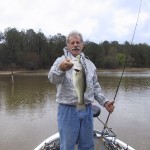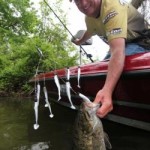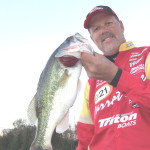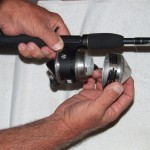Back in the early 1980s I was in a deer club where we had a terrible problem with “seed ticks” every fall. One day after hunting I saw my pants legs were covered with tiny moving dots. I had some Scotch Tape in the truck and stuck a bunch of them under a strip and took them to an entomologists at the University of Georgia Agricultural Experiment Station in Griffin.
He identified the ticks and gave me some background on the tick life cycle. I reviewed information on the internet to check my memory of this information. One good site on tick life cycle is: http://animals.howstuffworks.com/arachnids/tick2.htm
And on Lyme Disease at: http://en.wikipedia.org/wiki/Lyme_disease
Lyme Disease is a bacterial infection transferred to people by tick bites. The bacterium that causes the infection is Borrelia burgdorferi. When a tick bites you, it actually attaches with its mouth parts and feeds on blood. To keep your blood from clotting and ending its meal, the tick injects anti-clotting agents into its host. That is when the bacteria are injected into your body, where they grow and multiply.
Ticks are related to spiders and adult ticks have eight legs, making them arthropods, not insects. We have four kinds of ticks in this area that you are likely to encounter. American Dog Ticks, Black Legged Ticks, Lone Star Ticks and Brown Dog Ticks are all common in Alabama.
Their life cycle is complex. An adult female tick feeds on a host and fills with blood. After breeding, she drops to the ground and digs in. She will lay hundreds to thousands of eggs and, when they hatch, the tiny ticks climb onto grass stalks or bushes and wait on a warm-blooded host to come by. They get onto the host and get a meal of blood then drop off.
At the first stage of their life, the ticks are tiny, about the size of a pin head. Often called “Seed Ticks,” these young ticks can actually be any of the kinds of ticks that live around here. You aren’t likely to see them attached to you at this stage since they don’t feed long, but they leave an itching sore where they bite that shows up a day or two after they are gone. Since hundreds hatch in the same small area, you can get dozens on you at the same time.
The tiny ticks go back into the ground, molt and grow, then climb back up onto something to wait on a host again. At this stage the ticks are bigger and easier to see, but are usually still called seed ticks. They bite and attach a little longer before filling with blood and dropping off again. You sometimes start to itch while they are still attached at this stage.
After dropping off, the ticks will go through another molt then try to find a host a third time. They are mature at this point and will be bigger. You often feel them crawling on you and can spot them easier, and can even identify the type of tick. And they will stay attached much longer while feeding. This is the stage where the tick will be a big gray ball after filling with blood. At some point during this stage the tick will breed. The females then drop off, lay their eggs and start the cycle all over again.
Different kinds of ticks carry different diseases. The Brown Dog Tick mainly carries infections that affect dogs but Lone Star Ticks carry Tularemia and Lyme disease, the American Dog Tick carries Rocky Mountain Spotted Fever and Tularemia, and the Black Legged Ticks are the primary carriers of Lyme Disease and also carry human granulocytic ehrlichiosis. Since the different kinds of ticks are very hard to identify at different stages, all ticks should be considered dangers.
Growing up back in the 1950s, we seldom saw ticks except on our dogs, and almost never got them on us. They were just not that common. But something happened to make ticks much more widespread. Whitetail deer are favorite hosts of ticks and, as the deer population boomed, so did the tick population. By the late 1970s, it was hard to walk in the woods in warm weather without getting a tick on you.
I spend a lot of time outdoors and get bit by ticks way too often now. From April to October, if I go out to my ponds and walk around them, I will get ticks on me if I don’t spray carefully with repellant. Just playing with my dog can transfer ticks from him to me. Sitting on the ground turkey hunting is a very good way to get ticks too.
One of the most unusual ways I got ticks on me happened in April a few years ago. While practicing for a tournament at West Point Lake I answered a call of nature. When I got out of the boat, I commented to my partner about all the deer tracks on the bank in that area. That night I found three ticks on me, two crawling and one attached, when I took a shower.
In July I started to feel run down and tired all the time. Sometimes at night I felt like I was having a slight chill and running a low fever. By late August I did not want to do anything. I had to force myself to go fishing, and a club tournament was an ordeal I suffered through. Walking out to the mail box exhausted me.
In early September I made my annual fishing trip to northern Wisconsin. Even though the fish bit great, I could not fish longer than five or six hours each day, and felt miserable after that short a time. When I got home, I went to the doctor and told them to find out what was wrong with me.
A wide ranging variety of blood tests for all kinds of things came back positive for only one thing – Lyme Disease. The doctor said I could have been infected for months or even a year and the symptoms were just showing up. I never saw a rash or “bulls-eye” swelling around a tick bite that is supposed to be seen in 90 percent of the cases of an infection. I never found a tick on me that had been attached for more than a few hours, although it is claimed they need to be attached for 24 hours to transfer the infection.
The doctor put me on 200 milligrams of Tetracycline daily for 20 days and I started feeling better near the end of that treatment. Unfortunately, within a week after ending the antibiotic, I felt terrible again and was given ten more day of Tetracycline. It had no effect and another 20 days of it was prescribed.
I did a lot of reading and found out 20 days of Tetracycline was the accepted course of treatment, and was supposed to cure you. It was scary reading how Lyme Disease left untreated could affect your nervous system, heart and other organs and even cause death. I found articles saying there was a chronic form that was much harder to get rid of, often taking years of antibiotic treatments.
I also found out the Centers for Disease Control (CDC) had a map on their web site showing a low risk of Lyme Disease for most of Alabama and no or minimal risk in some far north areas. That really surprised me since everyone I talked with seemed to know someone who had tested positive for Lyme Disease.
At this point I had taken antibiotics for 50 days and still had the same symptoms. I was worried and went back to my doctor. He ran every test he could think of, taking eight vials of blood for them. All came back normal and he said there was really nothing he could do since the test said everything was ok.
One point was a little scary. He told me my Lyme Disease test was still positive, but it would always be positive. Once you get Lyme Disease your blood will always have the antigen that shows up positive in a blood test, so it really does not tell the doctor anything. You can still be infected or the infection can be gone, there is no way to tell.
For several weeks I managed to get by, feeling run down and tired all the time. It felt like someone had unplugged me and all my energy was gone. I could be sitting at my desk or lying in bed and just felt drained and did not want to do anything.
While talking to a local forester, I told him my experiences, and he said his son and gotten very sick with Lyme Disease and had gone through the same things without being cured. Then he found a doctor in Mobile that specialized in Lyme Disease and went to him. After a long struggle and months of antibiotics, he started getting better.
I contacted the doctor and got an appointment. He told me my experiences were common. He had been treating Lyme Disease for over 20 years, studying it and had come up with a course of treatment that helped about 95 percent of his patients. He ran several tests on me and said I was lucky that so far I didn’t have any neurological effects. He also said the approved course of antibiotics I had taken were not nearly strong or long enough.
He started me on 30 days of 500 milligrams of azithromycin a day plus a daily dose of Flagyl, a kind of antibiotic that will kill bacteria in the cyst stage. After three weeks of the dual antibiotics I started feeling better and actually wanted to get out and do things like cut wood and work around the house, something I had not felt like doing for almost six months.
That was the first stage of his four month treatment. The second stage is 250 milligrams of azithromycin daily for sixty days, then a fourth month of biaxin twice daily.
I still do not feel as good as I did last spring, but I no longer have the feeling of being exhausted all the time. I can actually enjoy fishing a club tournament for eight hours and the idea of turkey hunting doesn’t wear me out just thinking about it.
There are several things you can do to avoid ticks, but if you love hunting and fishing, it is much more difficult. Avoid grass and bushes where ticks may be waiting on you. Stay away from deer and dog trails in fields and woods. Wear light colored clothing so you can see ticks. Tuck your pant legs into boots or socks. And apply strong repellants. Some are made without smell so they won’t interfere with hunting, but use something anytime you are outside.
Watch out for pets that may bring ticks to you. If you have a dog, make sure you treat it for ticks and check yourself after playing with them. And remember, ticks can be anywhere, so always be careful when outside.
Avoid getting bit by ticks! If you do find a tick bite, be aware of any symptoms like fever, being tired all the time, weakness, confusion, headache or rashes. Watch for the bullseye swelling or rash. If you find a tick on you, stick it to some tape or put it in a small bottle of alcohol and show it to the doctor if you develop symptoms.
The blood test for Lyme Disease will not work for several weeks after the infection starts but let you doctor know if you have symptoms and have been bitten by a tick. And the test sometimes has false negatives, meaning you may have Lyme Disease and the test still show you do not have it.
It is best to seek a specialists in infectious diseases or, if you can find one, a doctor specializing in Lyme Disease treatment. I have heard stories of doctors that are skeptical of Lyme Disease infections or don’t know much about it and don’t even run the tests until it is too late.
Don’t let your symptoms go untreated – the sooner you get treatment the better your chances of getting over it. Left untreated, you could have serious health problems.







